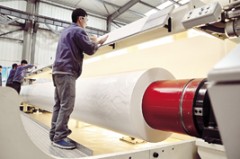Application
What are the benefits of using modified precipitated barium sulfate in the plastics industry?
1. Reduce costs. Generally, fillers are cheaper than resins, so adding fillers can greatly reduce the cost of plastics, and has significant economic benefits. This is also the main reason why plastic filling modification is widely used.
2. Improve the heat resistance of plastics. Generally, the heat resistance of plastics is low, such as ABS, its long-term use temperature is only about 60℃, and most of the fillers are classified as inorganic substances, and the heat resistance is high. Therefore, the addition of these fillers to the plastic can significantly improve the resistance of the plastic thermal. Another example is PP, when it is not filled, its heat distortion temperature is around 110°C, and after filling with 30% talc, its heat distortion temperature can be increased to over 130°C.
3. Improve the rigidity of plastics. Generally, the rigidity of plastics is poor. For example, the tortuosity modulus of pure PP is about 1000 MPa, which is far from satisfying the application requirements of some parts. After adding 30% talc, its tortuous modulus can reach more than 2000 MPa, which shows that talc has a significant stiffening effect.
4. Improve the molding processability of plastics. Some fillers can improve the processability of plastics, such as barium sulfate, glass beads, etc., can improve the fluidity of the resin, and then improve its processability.
5. Improve the dimensional stability of plastic products and components. Some plastic crystals are shortened greatly, resulting in a large shortening rate of their products, which are more easily deformed after coming out of the mold, and the size is unstable; and adding fillers can greatly reduce the shortening rate of the plastic, and then improve the dimensional stability of plastic products and parts.
6. Improve the surface hardness of plastics. Generally, the hardness of plastic is low, and the appearance is easily scratched, which affects the appearance, and then affects its appearance and decoration. The hardness of inorganic fillers is higher than that of plastics. After adding inorganic fillers, the surface hardness of plastics can be greatly improved.
7. Improve the intensity of progress. The tensile strength of general-purpose plastics is not high. After adding inorganic fillers, the tensile strength and bending strength of the plastics can be improved within the appropriate range of the filling amount, and then the engineering applicability of the plastics can be improved.
8. Give plastic some functions and increase the added value of plastic. Some fillers can give plastics some functions. For example, the addition of talc and calcium carbonate to PP can improve the antistatic function and printing function of PP; the addition of hollow glass beads to the plastic can improve the insulation function of the plastic; the increase of metal particles can improve the thermal conductivity and electrical conductivity of plastics.




